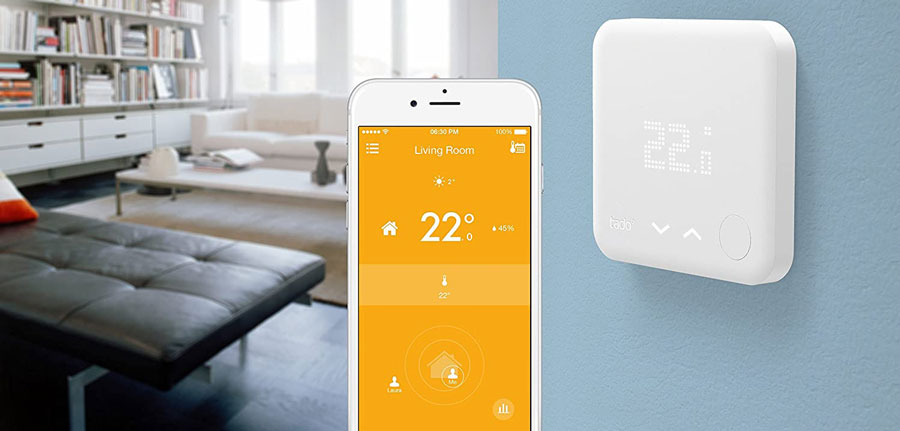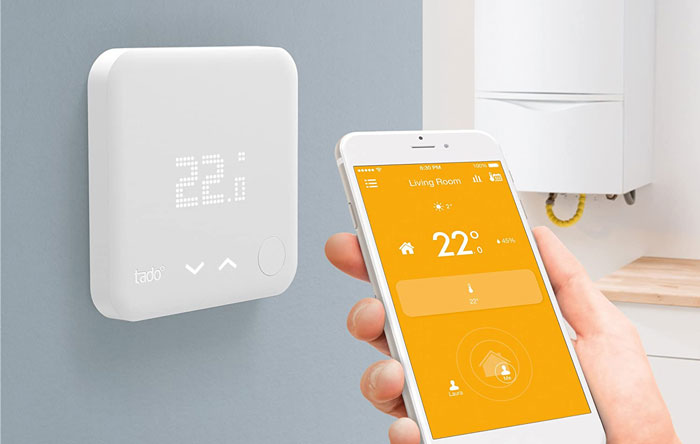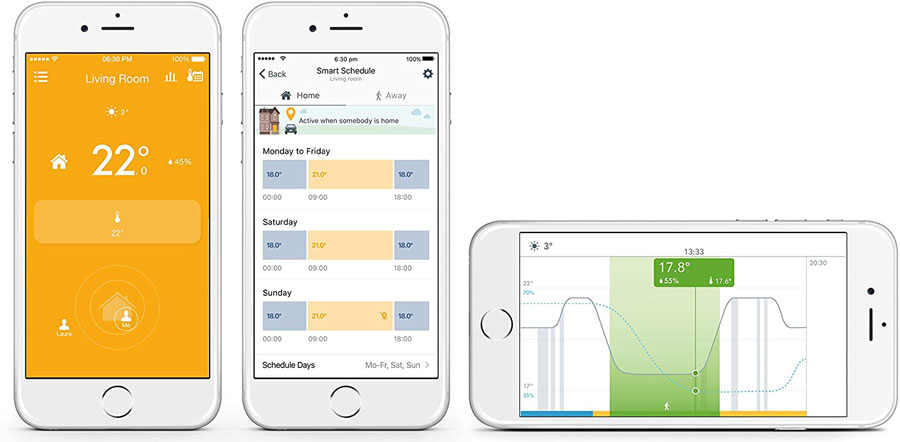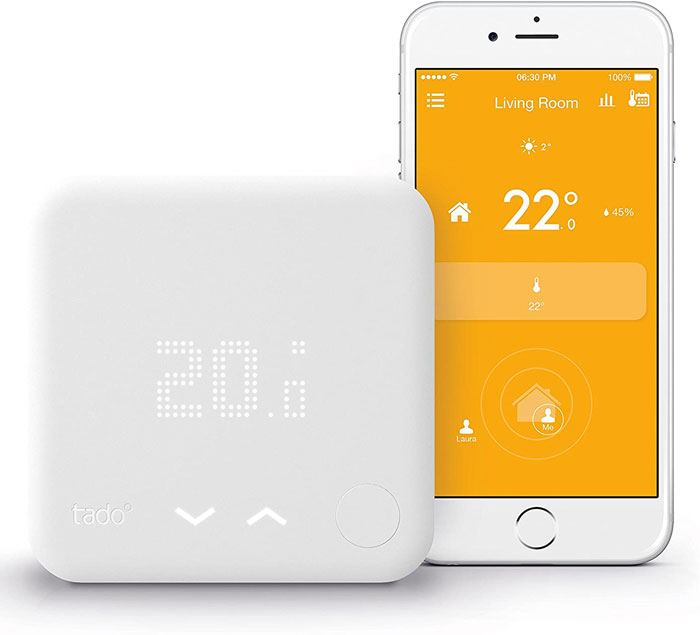How we heat our homes has changed a lot in the last few years. Most people are far more energy and cost-conscious than we were even a decade ago, and smart home controls are becoming the norm.
Already into its third version, the Tado Smart Thermostat promises a lot but genuinely manages to deliver on almost all of it. Long story short, it offers a system that’s flexible enough to work in every home, easy to set up, with a host of impressive features.
Already approved by the UK Energy Savings Trust, installing Tado should save you up to 27 percent on your energy bill. Considering average heating costs, that means a normal Tado installation should pay for itself within a year or two.
So what is the Tado?
The basic Tado option is the Smart Thermostat Starter Kit; which gives you everything you need to get started.
The main kit comes with a direct replacement for your wall thermostat, as well as a small USB dongle that plugs into your router which gives it access to wireless internet and smart home integration.
For homes that don’t have a thermostat, Tado offers an expansion kit that plugs directly into your boiler, giving the device the control it needs to regulate your heating and hot water, using OpenTherm technology.
Building on this, the full range includes extra options, including specific radiator thermostats, extra receivers, temperature sensors, and more, giving you the tools you need to individually monitor and control every room in your home, if necessary.
How does the Tado work?

The Tado system is built around two main components. The smart thermostat and its sensors, and the app.
In terms of design, everything on offer certainly looks impressive. All the component parts of the smart system, whether that’s the sleek, rounded edges of the wall thermostat, to the clipped, circular design of the radiator controllers, is attractive in that neutral, modern way, and will slot unobtrusively into almost any home’s décor.
Despite looking simple, there is a lot to love in the design, especially the LED display, which shows up on the casing itself as if projected and looks futuristic and gorgeous. Installation is also simple. If you’ve ever done anything similar, the instructions will be easy to follow, and if not, or you don’t feel comfortable working on your own plumbing and electrics, you can pay a little extra for a professional install.
Out of the box, the Tado integrates straight into your smart home setup. The app, accessible using any phone or tablet, does most of the heavy lifting, but you can link Tado straight into any IFTTT system, and it plays happy families with all of the standard smart home hubs including Alexa and Google Assistant.
All of this is simple to understand, and apart from the initial thermostat, is basically plug and play, which means that expansion is effortless. When it comes to design, there are no complaints.
Controls and the app

The app that works alongside the Tado is just as solid as the devices themselves. For starters, it’s well laid out and simple to understand and adjust. Heating can be left to the app on fully automatic mode, which is going to be sufficient 90% of the time.
If you need a little more control, you can shift the temperature with a couple of button presses, to a minimum of 5 or a maximum of 25 degrees. This isn’t the biggest range, but it’s almost expected, with Tado’s focus on efficiency and energy saving.
Scheduling is simple to do and can be set on a day by day, and room by room, basis. This gives you a lot of control over your home, and lets you heat up sections when they’re likely to be used, and leave out areas of your house that aren’t needed that day.
The September 2025 update brought with it a bunch of new features, including real-time energy costs, letting you see at a glance, on a daily basis what your energy bill is, and how you can save, as well as real-time air freshness features and improvements to the smart scheduling feature. It’s nice to see a company commit to the constant improvement of their services like this, and it’s a mark of confidence, especially considering how everything is also backwards compatible.
Geofencing and location

For a lot of people, the biggest draw of Tado’s app is the geofencing feature. This uses GPS and other geolocation functions on your phone to update your location and starts to switch off heating when there is no one in the home.
If you’re security-minded, you don’t need to worry. Even if you turn off your phone’s location tracking features, it can use triangulation features from phone towers to get a rough estimate of where you are, without having to pinpoint and track you precisely down.
One feature that we found really impressive is the fact that you can set a geofencing radius. This means that set correctly, you can pop down to your local shop for a pint of milk without your heating switching off, but as soon as you head further, everything shuts down and saves you money.
It is worth pointing out that anything past the V3 doesn’t have this as a standard feature. Instead, it pings your phone and encourages you to turn things off via the app. More on this later.
Another great feature is the Care & Protect service, which constantly monitors the heating system and acts as the first line of warning. Once it’s calibrated, if the system detects irregularities, it pings you a warning, giving you more chance to call a professional.
Overall impressions
The good
There are a lot of reasons to recommend the Tado, and it’s a service that’s going to comfortably slip into most homes without any issues.
For starters, the geofencing feature is fantastic. It’s well-calibrated and great at picking up when people aren’t in the home, so as long as it’s enabled, the whole system is basically fire and forget.
Installation is easy, with simple to follow instructions, and the option for professional installation if you need it. The ease of expansion is another huge draw, as it lets you install the main unit and build on it as necessary, or buy extra sensors for rooms that are a particular problem.
The app is great and has obviously been designed with a lot of care and attention to user experience, and most people will love the option to plug this directly into your smart home setup and have it just work without any complicated issues.

The bad
The subscription service feels needed
As we’ve already mentioned, some features are locked behind the paywall. This feels doubly unfortunate when you realise that these features came as a standard before the V3 model, and they’re surprisingly essential if you want to use the full features of your new purchase.
The two main features that the subscription service unlocks are:
- Window detection, which turns off your heating if a door or window is open
- Geofencing, the setting which detects whether there are people in the home and adjusts the heating accordingly.
The subscription cost is cheap (£2.99 per month at the time of writing, with a discount on yearly costs) and you can cancel your subscription at any time, but it still feels a little stingy to have to pay more for services that used to be standard. Still, what’s on offer is more than worth the price of a cup of coffee a month, and you can always choose not to use it and have a perfectly serviceable automated system that just needs you to push a single button on your phone whenever you leave the house.
Final thoughts
There’s no doubt that the Tado is an impressive piece of gear. While there are a few minor negatives, including the shift to a subscription service for some of the features, we expect this to become standard practice in the coming years, and the overall savings more than makeup for any potential long term costs.
Long story short, the Tado will save you time, money and energy. It genuinely works, and you’re never going to regret installing it.







